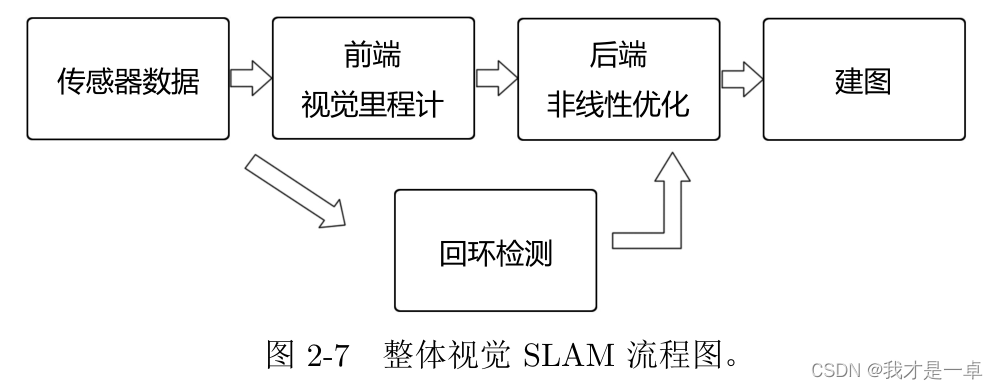SLAM导航中的视觉里程计:原理与实现
发布时间: 2024-07-14 21:27:25 阅读量: 76 订阅数: 42 


视觉里程计:起源、优势、对比、应用.zip

# 1. 视觉里程计概述**
视觉里程计(VO)是一种通过分析图像序列来估计相机运动的计算机视觉技术。它在SLAM(即时定位与地图构建)系统中扮演着至关重要的角色,为机器人或其他移动设备提供实时定位和导航能力。
VO通过提取和匹配图像序列中的特征点来估计相机位姿。它使用数学模型来描述相机和运动,并通过优化算法来估计相机运动参数。VO的精度和鲁棒性对于SLAM系统至关重要,因为它直接影响着机器人或设备在环境中的定位和导航能力。
# 2.1 视觉里程计的数学模型
### 2.1.1 相机模型
视觉里程计的数学模型建立在相机模型的基础上。相机模型描述了相机将三维世界中的点投影到二维图像平面的过程。常用的相机模型包括针孔相机模型和透视相机模型。
**针孔相机模型**
针孔相机模型假设相机是一个小孔,光线从三维世界中的点通过小孔投影到图像平面上。针孔相机模型的数学表达式为:
```
[x, y, z] = f * [X/Z, Y/Z, 1]
```
其中:
* `[x, y, z]` 是图像平面上的点坐标
* `[X, Y, Z]` 是三维世界中的点坐标
* `f` 是相机的焦距
**透视相机模型**
透视相机模型更真实地模拟了实际相机的成像过程。它考虑了透镜畸变和径向畸变等因素。透视相机模型的数学表达式为:
```
[x, y, z] = f * [X/Z, Y/Z, 1] + [c_x, c_y, 0]
```
其中:
* `[c_x, c_y]` 是图像平面的主点坐标
### 2.1.2 运动模型
运动模型描述了相机在三维空间中的运动。常用的运动模型包括平移模型和仿射变换模型。
**平移模型**
平移模型假设相机在三维空间中只进行平移运动。平移模型的数学表达式为:
```
[X', Y', Z'] = [X + t_x, Y + t_y, Z + t_z]
```
其中:
* `[X', Y', Z']` 是相机运动后的坐标
* `[X, Y, Z]` 是相机运动前的坐标
* `[t_x, t_y, t_z]` 是相机在三个方向上的平移量
**仿射变换模型**
仿射变换模型更一般地描述了相机在三维空间中的运动,它包括平移、旋转和缩放等变换。仿射变换模型的数学表达式为:
```
[X', Y', Z'] = [A * X + B * Y + C * Z + t_x, D * X + E * Y + F * Z + t_y, G * X + H * Y + I * Z + t_z]
```
其中:
* `[A, B, C, D, E, F, G, H, I]` 是仿射变换矩阵
* `[t_x, t_y, t_z]` 是相机在三个方向上的平移量
# 3. 视觉里程计的实现
### 3.1 视觉里程计的框架设计
#### 3.1.1 系统架构
视觉里程计的系统架构通常包括以下模块:
- **图像采集模块:**负责采集图像数据。
- **特征提取模块:**从图像中提取特征点。
- **特征匹配模块:**将相邻图像中的特征点进行匹配。
- **位姿估计模块:**根据匹配的特征点估计相机位姿。
- **数据管理模块:**管理图像数据和位姿估计结果。
#### 3.1.2 数据流处理
视觉里程计的数据流处理过程如下:
1. 图像采集模块采集图像数据。
2. 特征提取模块从图像中提取特征点。
3. 特征匹配模块将相邻图像中的特征点进行匹配。
4. 位姿估计模块根据匹配的特征点估计相机位姿。
5. 数据管理模块存储图像数据和位姿估计结果。
### 3.2 视觉里程计的算法实现
#### 3.2.1 特征点跟踪
特征点跟踪是视觉里程计中至关重要的步骤,其目的是在相邻图像中跟踪特征点的运动。常用的特征点跟踪算法包括:
- **光流法:**利用图像亮度梯度信息跟踪特征点。
- **KLT 算法:**基于最小二乘法跟踪特征点。
- **SIFT 算法:**基于尺度不变特征变换跟踪特征点。
#### 3.2.2 位姿估计
位姿估计是根
0
0





